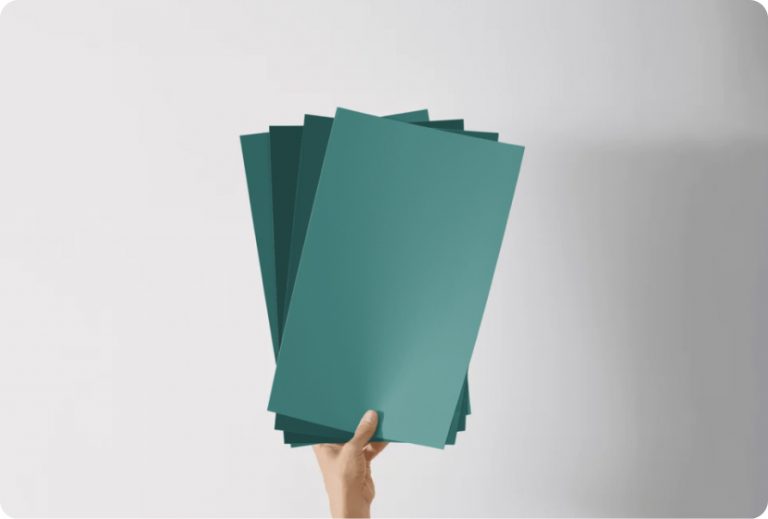I recently painted my living room with HC-28 Shelburne Buff by Benjamin Moore and I must share how impressed I am with the results. If you’re considering a fresh look for your home, understanding the qualities and ambiance that HC-28 Shelburne Buff brings is crucial.
This particular shade has a soft, warm hue that brightens the room while offering an air of refinement and comfort. The color blends seamlessly with different decors, enriching wood elements and contrasting beautifully with dark furniture. Perfect for anyone looking to create a cozy yet enduring look for their area, Shelburne Buff proves itself as a adaptable and appealing choice.
Whether it’s my morning coffee or evening downtime, the walls now contribute to a relaxed and inviting atmosphere, making my choice seem like an inspired one.
My reflection on using this paint underscores its ability to provide an enduring charm without being intense.
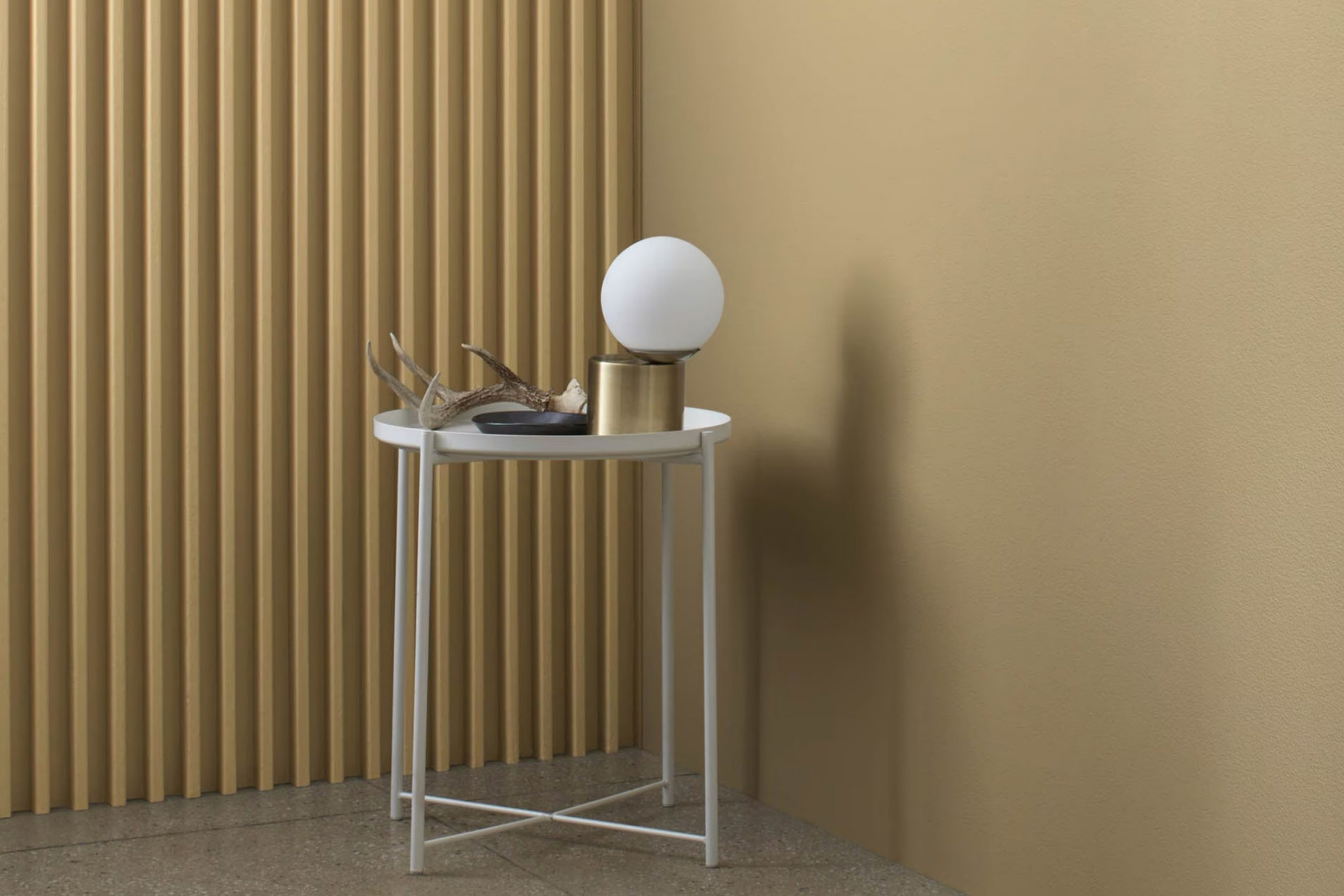
What Color Is Shelburne Buff HC-28 by Benjamin Moore?
Shelburne Buff HC-28 by Benjamin Moore is a warm, welcoming shade of beige that has the subtle richness of sunlit sand. This color exudes a gentle, cozy feel, making it perfect for creating a relaxed and inviting atmosphere in any room. With its soft and muted tones, it pairs beautifully with a wide range of decor styles, particularly traditional, rustic, and contemporary.
In terms of interior styles, Shelburne Buff works especially well in living rooms and bedrooms where comfort and calmness are key. It’s an ideal backdrop for areas that feature natural materials, such as wood, leather, and linen. This paint color also complements well with textured fabrics like burlap or wool, adding depth and interest to the overall aesthetic of a room.
Shelburne Buff is adaptable when it comes to coordinating with other colors. It looks stunning with rich browns, deep greens, and creamy whites, creating a harmonious and balanced look. Accentuating this color with metallic tones like brass or gold can add a touch of warmth, making the area feel more inviting.
Overall, Shelburne Buff HC-28 is a solid choice for those looking to create a cozy, soothing environment in their homes without being intense to the senses. Its flexibility with various materials and textures makes it practical and stylish for enduring interior designs.
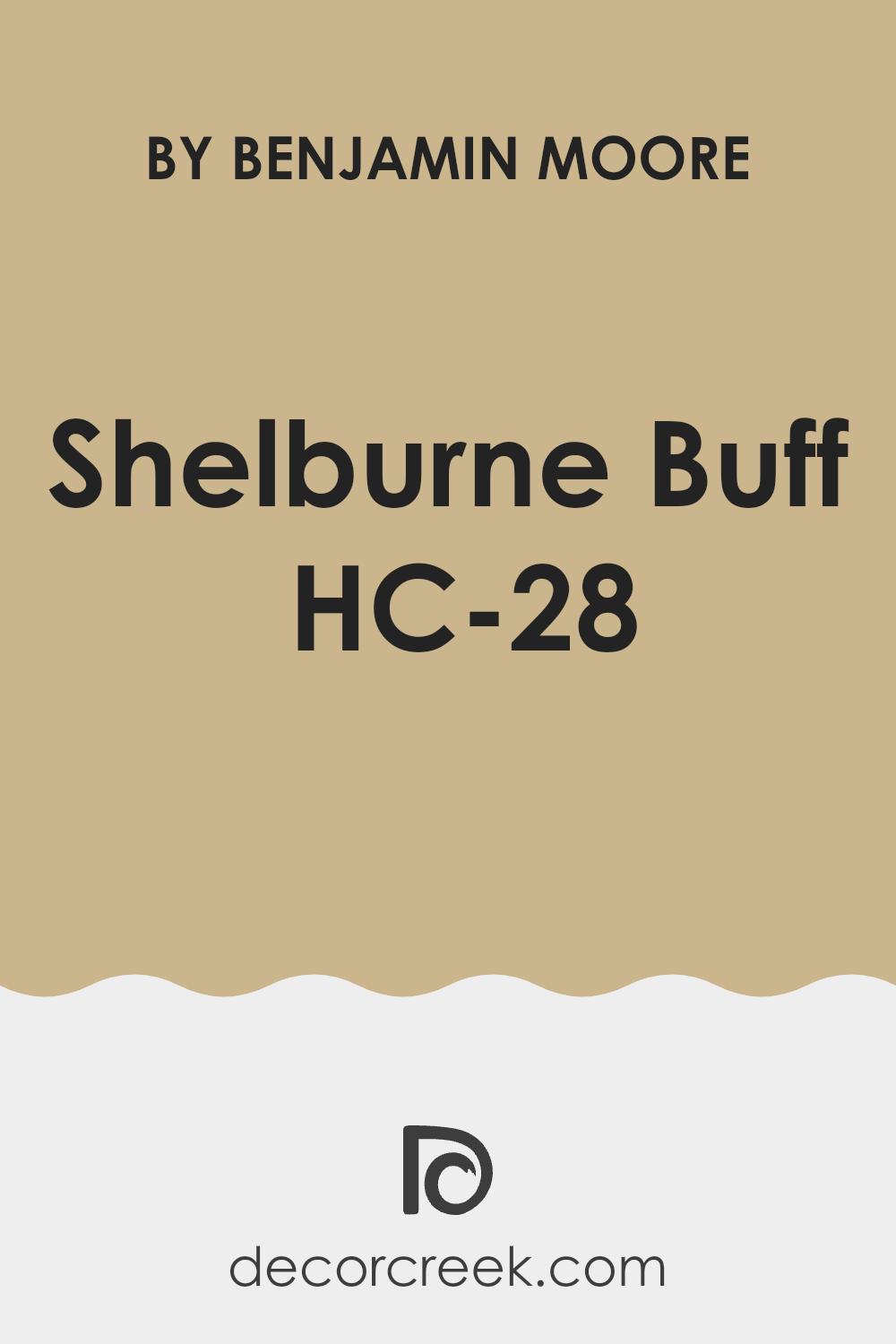
Is Shelburne Buff HC-28 by Benjamin Moore Warm or Cool color?
Shelburne Buff HC-28 by Benjamin Moore is a warm, welcoming paint color that can make any room feel cozy and inviting. This shade of beige has soft yellow undertones, which help to add brightness and warmth to rooms. It’s especially effective in areas that don’t get a lot of natural sunlight, as it can help make them appear lighter and airier.
This color fits well in many parts of the home. For example, using it in a living room can create a comfortable area where family and guests can relax. It’s also great for bedrooms, providing a calm backdrop that helps you unwind at the end of the day.
Moreover, Shelburne Buff HC-28 is quite adaptable when it comes to styling. It pairs beautifully with a wide range of colors, from crisp whites and soft creams to rich browns and dark blues. This makes it easy to use no matter what your existing decor looks like, allowing you to refresh your room without needing to completely redo it. Overall, Shelburne Buff HC-28 offers a practical and pleasant option for anyone looking to update their home.
Undertones of Shelburne Buff HC-28 by Benjamin Moore
Shelburne Buff is an adaptable paint color with a complex mix of undertones. These undertones include pale pink, light gray, mint, light purple, grey, yellow, light blue, orange, lilac, light green, and olive. Each of these subtle hues can affect how we perceive the main color under different lighting conditions.
In general, undertones can influence the overall warmth or coolness of a color. For example, yellow or orange undertones could make a color appear warmer, whereas blue or grey undertones might make it seem cooler. Understanding these undertones is crucial when choosing paint colors, as they can significantly impact the mood and feel of a room.
When applied to interior walls, Shelburne Buff’s undertones interact with both natural and artificial light to subtly change its appearance throughout the day. In bright sunlight, the yellow or mint undertones might make the walls seem more vibrant and lively. In the evening, under artificial light, the pink or light purple undertones could give the area a cozy, welcoming glow.
This chameleon-like quality can be advantageous, allowing the room to adjust to different uses and lighting conditions. Whether creating a restful bedroom atmosphere or a friendly living room area, Shelburne Buff’s complex undertones provide a flexible backdrop that can enhance various interior styles and settings.
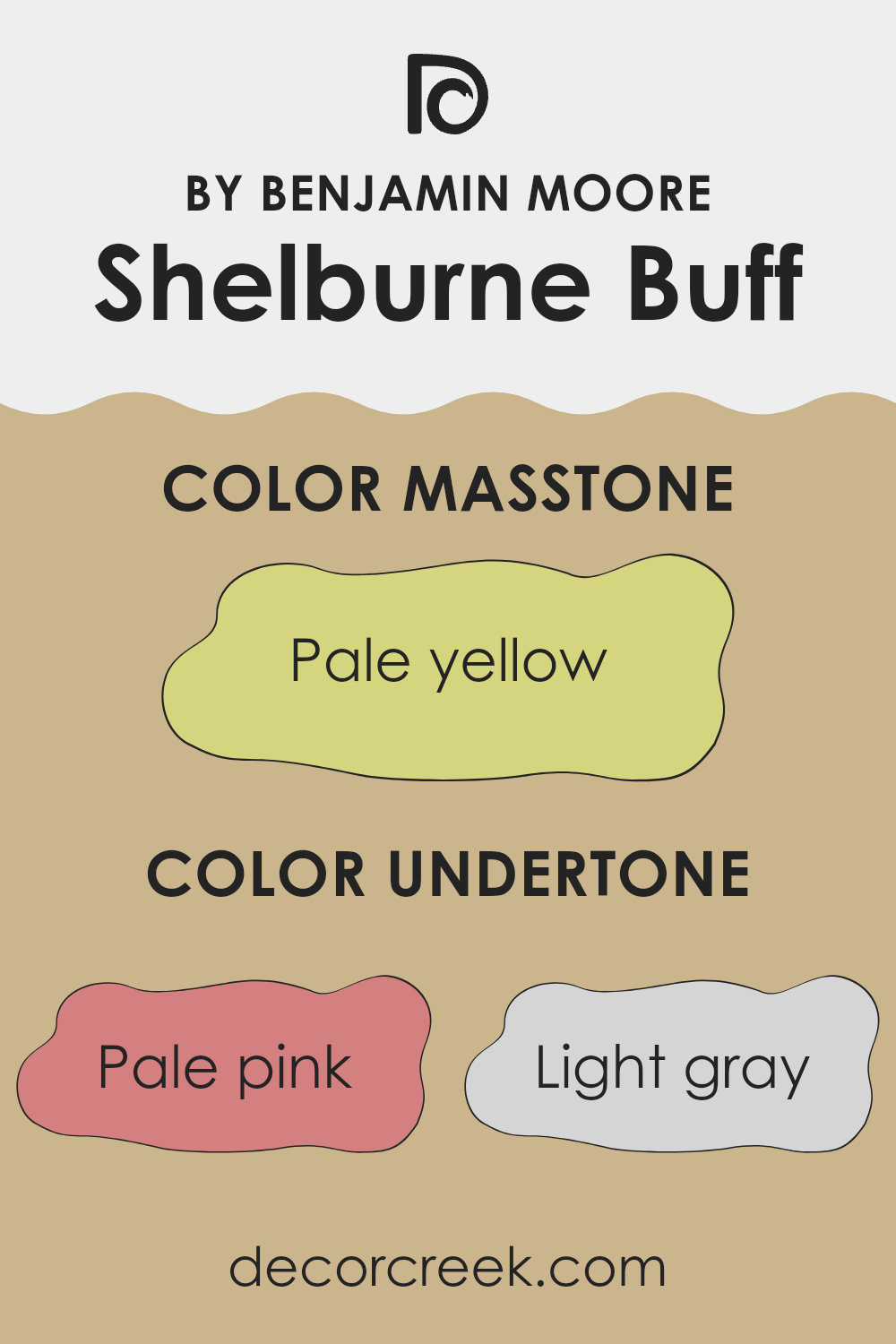
What is the Masstone of the Shelburne Buff HC-28 by Benjamin Moore?
Shelburne Buff HC-28 by Benjamin Moore, with its masstone in pale yellow (#D5D580), delivers a gentle and inviting vibe to any room. This shade of yellow is soft and not too bright, making it easy to match with other colors in home decor, from furniture to curtains.
The subtle warmth of this pale yellow can make rooms feel cozy and more welcoming, which is perfect for living rooms or bedrooms where you want a comfortable and relaxed atmosphere. Since it’s not a bold color, it doesn’t overpower other elements in the room, allowing for adaptable design options.
Whether paired with darker hues to add contrast or blended with similar soft colors for a harmonious look, Shelburne Buff HC-28 provides a beautiful backdrop. It’s particularly effective in rooms that get plenty of natural light, enhancing the light’s effect and making the room look larger and airier.
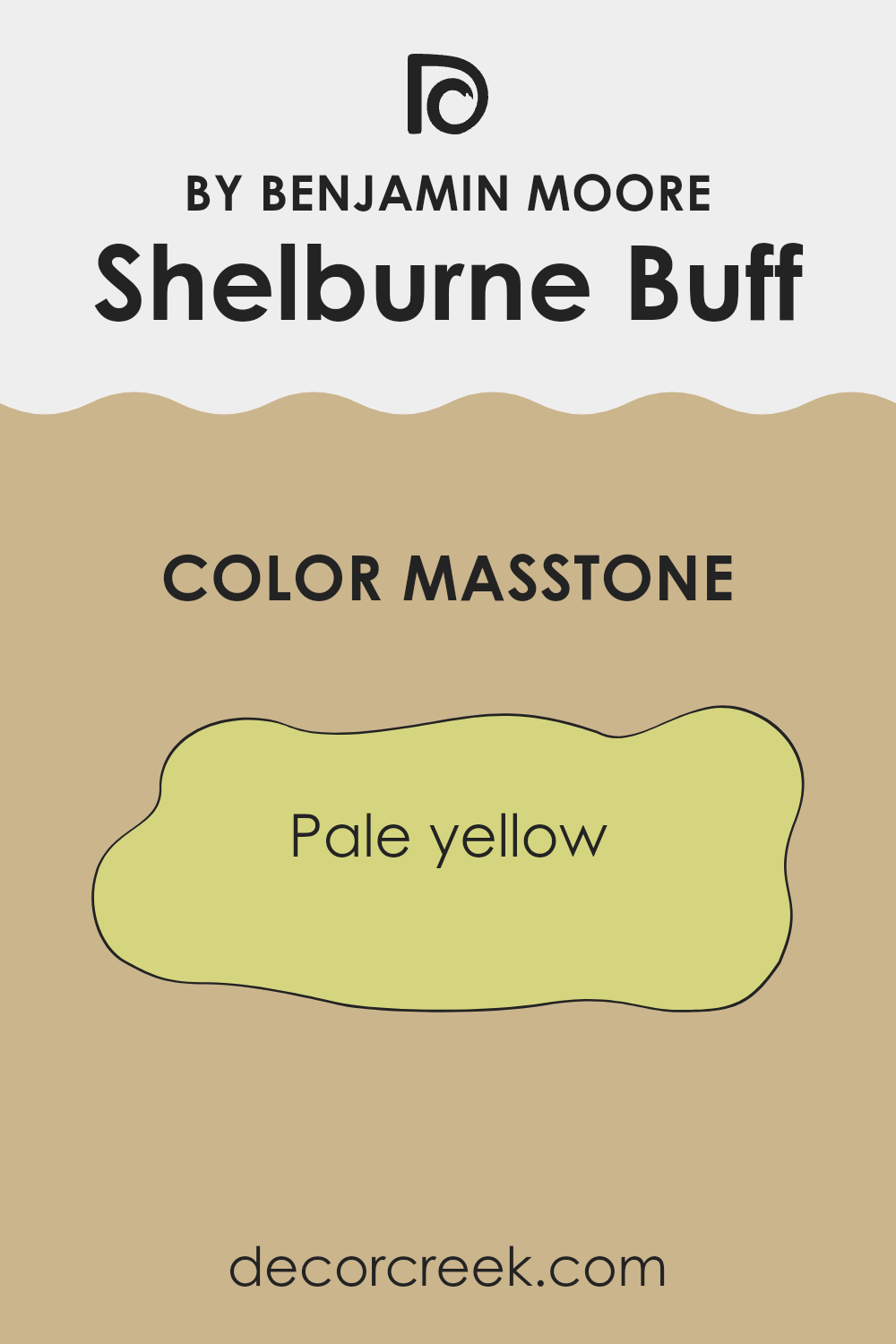
How Does Lighting Affect Shelburne Buff HC-28 by Benjamin Moore?
Lighting plays a critical role in how colors appear in different environments. Whether it’s natural daylight or artificial lighting, the type of light can change the way a paint color is perceived.
When considering a color like Shelburne Buff by Benjamin Moore, how it appears can vary significantly under different lighting conditions. In natural light, Shelburne Buff has a warm, welcoming quality that can make rooms feel cozy and inviting. This is because natural light, particularly sunlight, tends to bring out the richness and depth of warmer tones.
In artificial lighting, the appearance of Shelburne Buff can change depending on the type of bulbs used. For instance, LED or fluorescent lights that emit a cooler, bluer light can make Shelburne Buff look slightly more muted and less warm, while incandescent lighting, which is warmer, will highlight its golden tones.
The direction a room faces also impacts how Shelburne Buff will look:
- North-Faced Rooms: These rooms get less direct sunlight, which can make Shelburne Buff appear more subdued and slightly cooler in tone. It may lose some of its warmth but still provides a soft, neutral backdrop.
- South-Faced Rooms: With ample sunlight, Shelburne Buff will look its best, appearing warmer and more vibrant. The abundant light enhances its cozy appeal, making it a great choice for living areas and kitchens.
- East-Faced Rooms: In rooms that face east, Shelburne Buff will be brighter and more cheerful in the morning when the sunlight is warmer. As the day progresses, it might appear cooler and more neutral, matching the change in daylight.
- West-Faced Rooms: These rooms see the most change, as the light shifts from minimal in the morning to intense in the late afternoon. Shelburne Buff will shift from a more subtle, muted shade in the morning to a rich, warm tone by evening.Understanding how lighting affects colors like Shelburne Buff can greatly influence your decision when choosing paint for different rooms, ensuring you achieve the desired effect no matter the lighting condition.
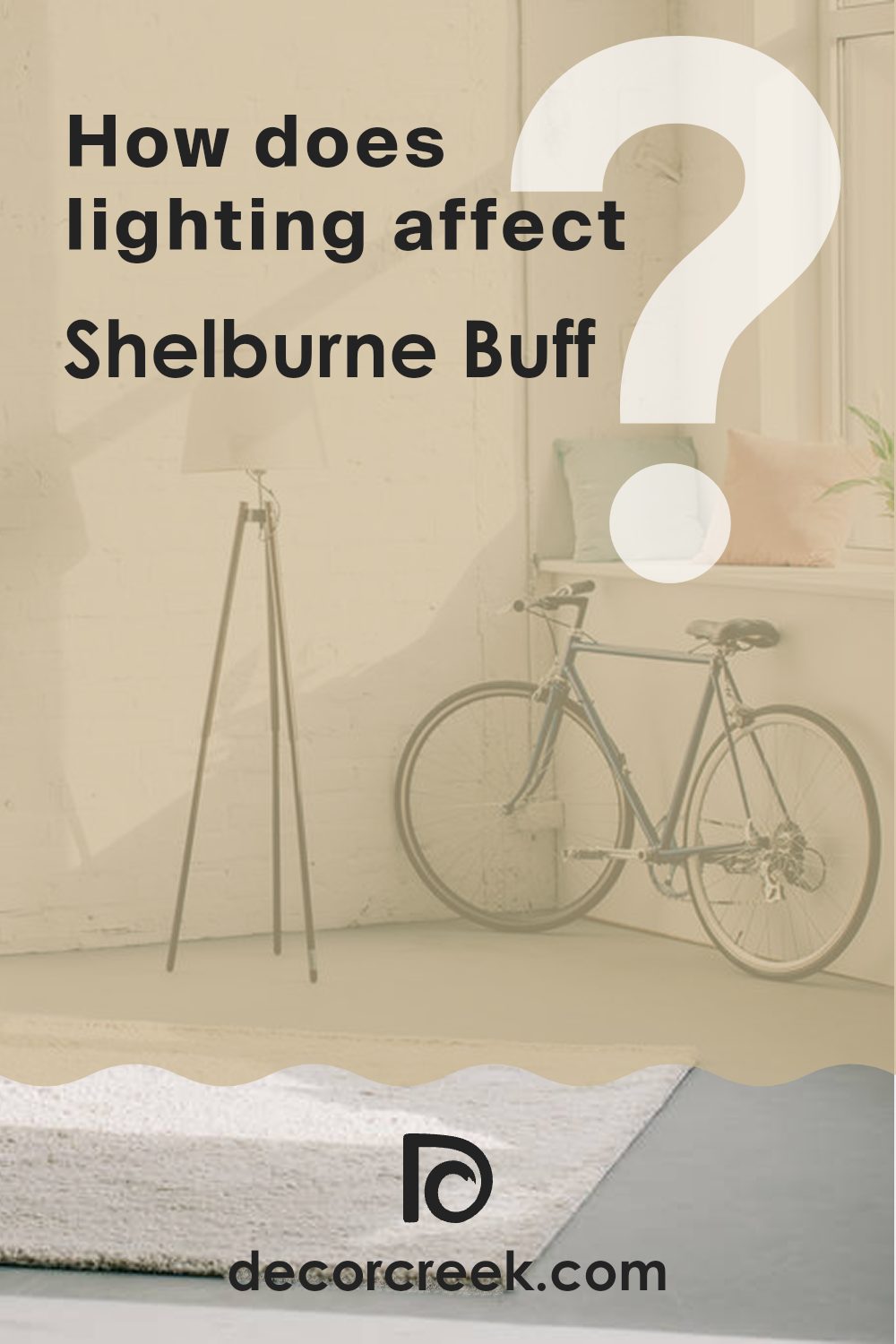
What is the LRV of Shelburne Buff HC-28 by Benjamin Moore?
LRV stands for Light Reflectance Value, which measures the percentage of light a paint color reflects off a surface back into the room. This value helps in understanding how light or dark a color will appear once it’s painted on a wall.
High LRV colors reflect more light, making a room feel brighter and larger, whereas low LRV colors absorb more light, giving a room a cozier and more shadowed feel. This measure is crucial when choosing paint colors for an area because it affects not only the aesthetics but also the mood.
For the color Shelburne Buff, which has an LRV of 47.16, it falls near the middle of the LRV scale. This means it is neither too dark nor too light. In practical terms, Shelburne Buff will reflect a moderate amount of light, making it adaptable for use in various lighting conditions, whether in a dimly lit hallway or a sun-filled room. The balanced LRV helps this color maintain its presence without overpowering an area, ensuring that the room feels inviting and comfortable under different lighting scenarios.
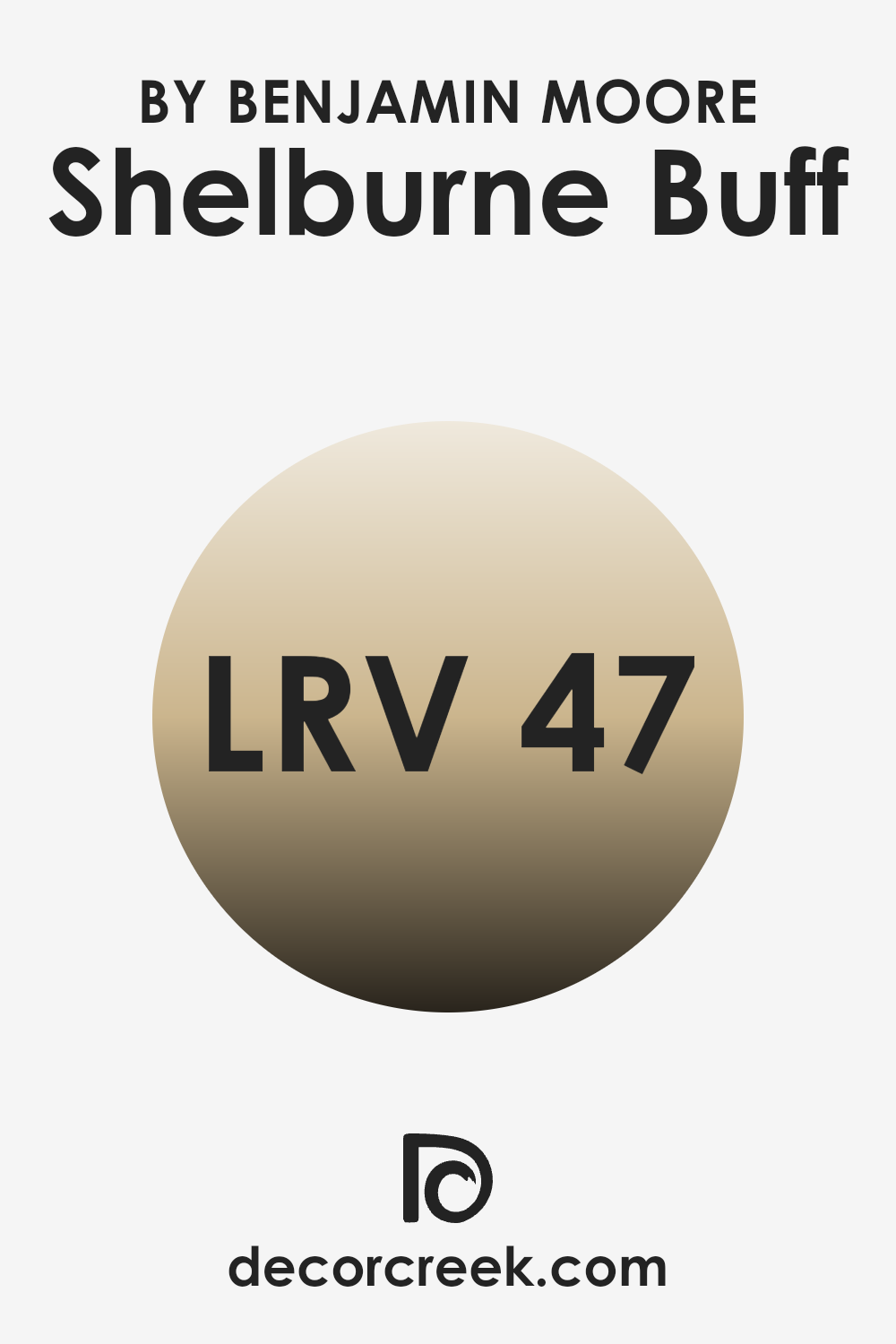
Coordinating Colors of Shelburne Buff HC-28 by Benjamin Moore
Coordinating colors are chosen to complement one another and create a cohesive look within a room. These colors are carefully selected to either contrast or blend with the primary color, enriching the overall aesthetic of an area. For instance, when you have a primary color like a warm beige such as Shelburne Buff, the coordinating colors are picked to harmonize and highlight this base tone.
Colors like Rainy Afternoon and Valley Forge Brown provide a deeper contrast to Shelburne Buff, adding depth and interest to the room. Rainy Afternoon is a muted shade of blue-green, reminiscent of a stormy sky, which pairs well with the warmth of Shelburne Buff to balance it with a cooler tone.
On the darker side, Valley Forge Brown offers a rich, earthy presence that grounds the lighter hues in the area. For a smoother transition and softer complementary tones, Mayonnaise and Linen White are excellent choices.
Mayonnaise is a creamy, almost buttery white that adds a gentle brightness to the room. Linen White, with a hint of warmth, seamlessly blends with Shelburne Buff, helping to create a soothing and cohesive atmosphere. Together, these coordinating colors work to highlight the charm of the main shade while providing a pleasing color palette.
You can see recommended paint colors below:
- 1575 Rainy Afternoon
- OC-85 Mayonnaise
- OC-146 Linen White
- HC-74 Valley Forge Brown
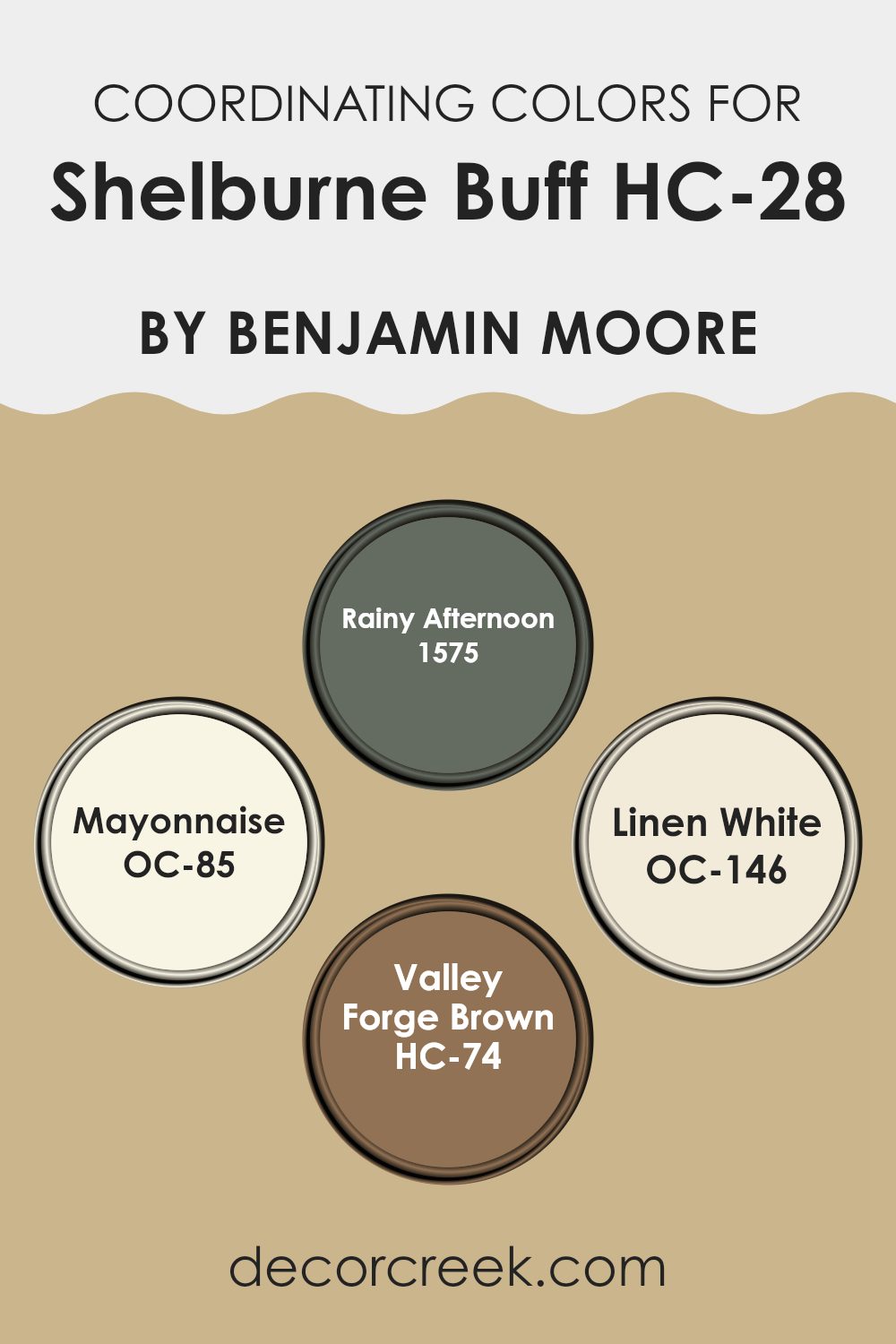
What are the Trim colors of Shelburne Buff HC-28 by Benjamin Moore?
Trim colors, which include hues used on door frames, window sills, moldings, and baseboards, play an essential role in defining the visual appeal and flow of a room. When paired with a primary wall color like Shelburne Buff from Benjamin Moore, trim colors such as OC-122 Cotton Balls and OC-152 Super White are important as they create a crisp, clean boundary and enhance the overall atmosphere.
The contrast they provide can effectively highlight the architectural details of an area, making the room appear more polished and cohesive. OC-122 Cotton Balls is a clean, vibrant white with a subtle touch of warmth that prevents it from appearing too stark. It is particularly effective in balancing the warmer tones of Shelburne Buff, providing a soft yet fresh look.
On the other hand, OC-152 Super White offers a pure, bright white that brings a lively contrast, ensuring that rooms feel more open and airy. This color is excellent for use in areas that receive a lot of natural light, as it helps to reflect the light and make the interiors feel brighter.
You can see recommended paint colors below:
- OC-122 Cotton Balls
- OC-152 Super White
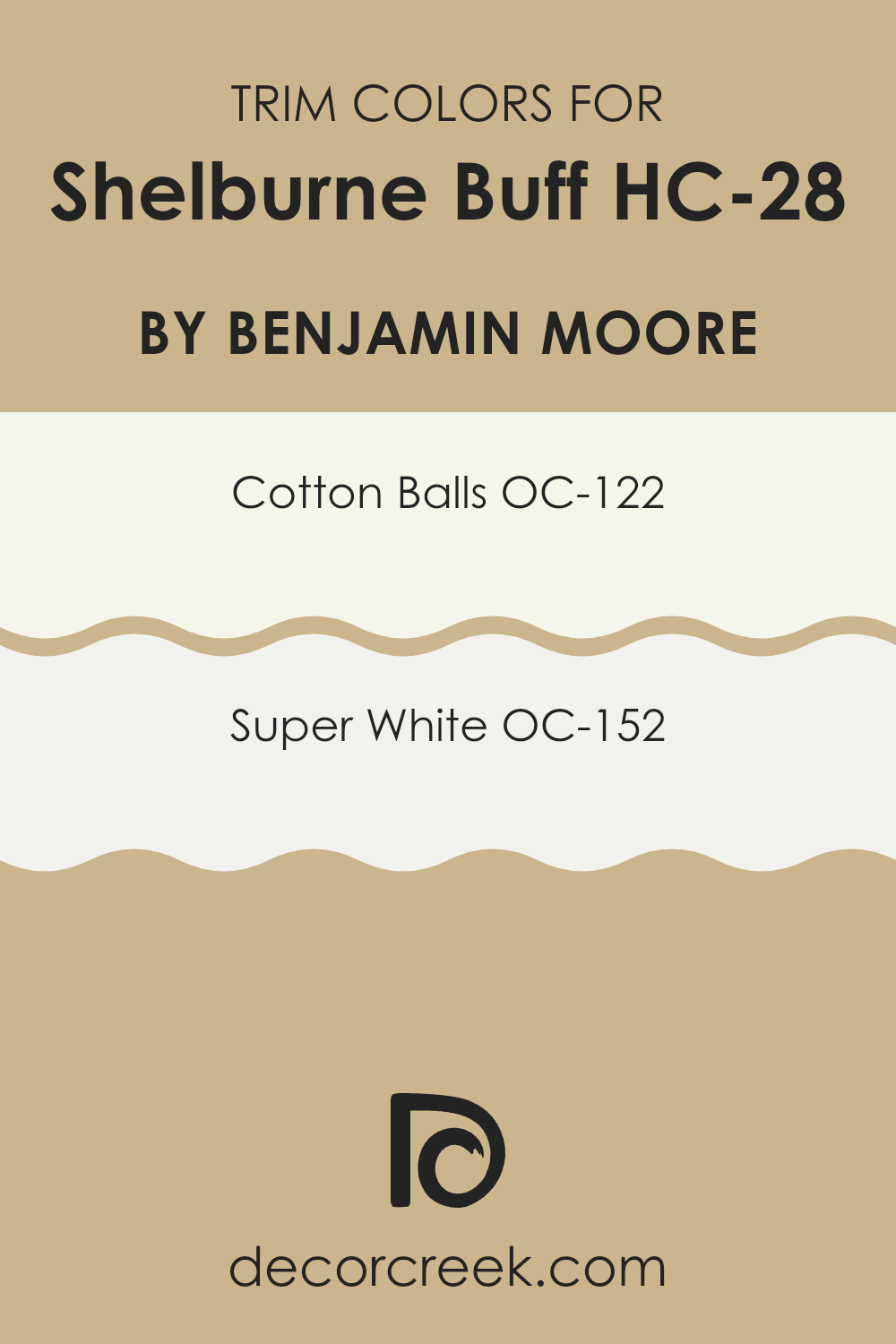
Colors Similar to Shelburne Buff HC-28 by Benjamin Moore
Choosing similar colors in design can create a harmonious and cohesive look that is visually appealing and soothing. For instance, tones like Oat Straw AF-340, Wilmington Tan HC-34, Shakespeare Tan 228, and Splendour AF-385 complement Shelburne Buff HC-28 by creating a subtle and soft ambiance. These colors work together by blending gently into one another, avoiding sharp contrasts that might interrupt the flow of the room.
Using colors with similar saturation and brightness helps to maintain a balanced aesthetic, which is particularly beneficial in rooms aiming for a calm and cozy atmosphere. It’s a method often used in areas where the goal is to have a unified look that gradually shifts from one shade to another, creating a layered yet connected feel.
Oat Straw AF-340 is a warm, gentle beige that conveys a sense of understated warmth, making it a perfect companion to Shelburne Buff. Wilmington Tan HC-34 offers a deeper, golden hue that adds richness without overpowering its lighter counterparts like Shelburne Buff. Meanwhile, Shakespeare Tan 228 presents a dustier version of tan that works well in settings seeking a muted but warm palette.
Lastly, Splendour AF-385 provides a more intense shade, similar to a deep beige with golden undertones, adding depth to the overall scheme when paired with Shelburne Buff and its related hues. These tones complement one another beautifully, ensuring a smooth and balanced visual transition in decor.
You can see recommended paint colors below:
- AF-340 Oat Straw
- HC-34 Wilmington Tan
- 228 Shakespeare Tan
- AF-385 Splendour
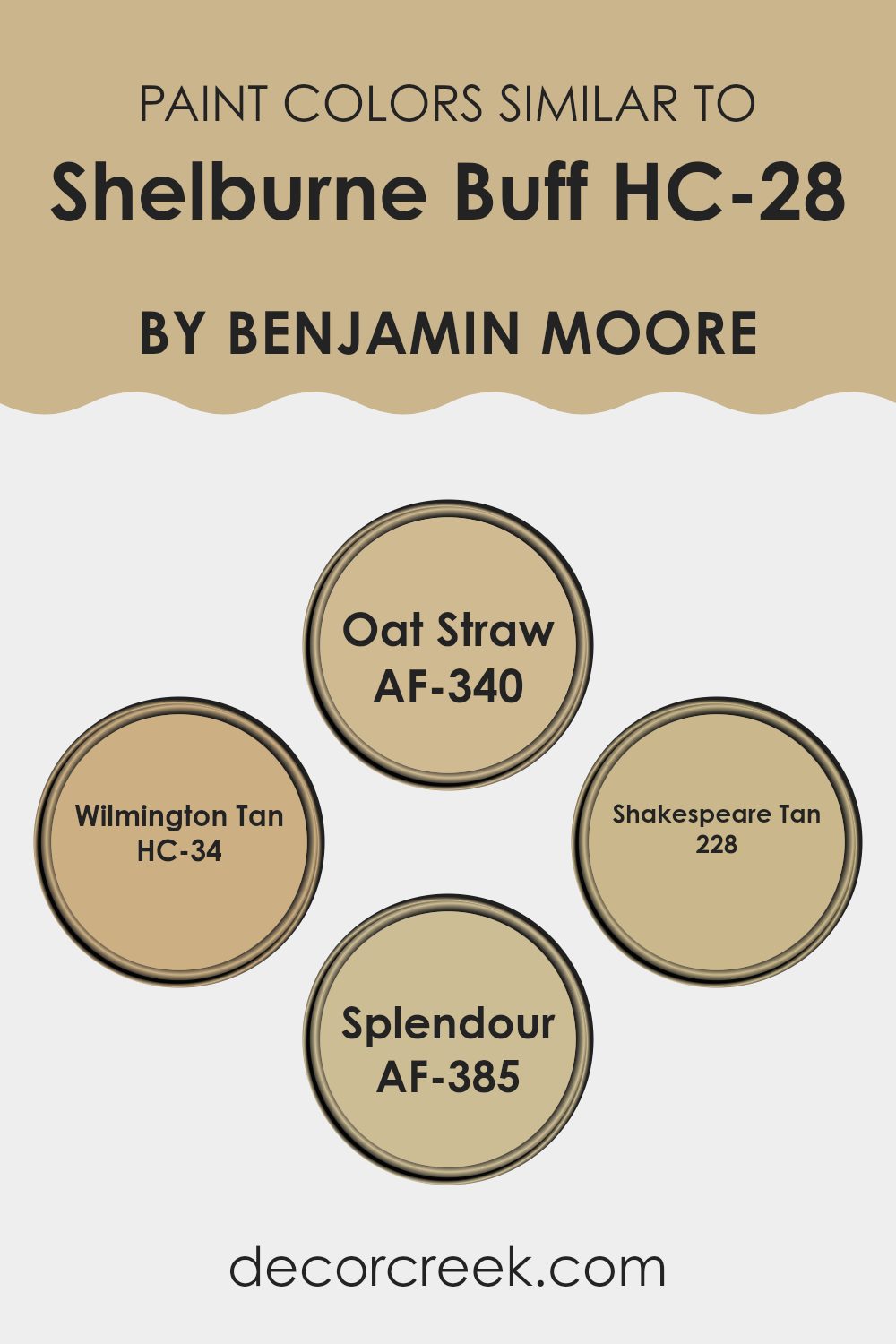
Colors that Go With Shelburne Buff HC-28 by Benjamin Moore
Choosing complementary colors for Shelburne Buff HC-28 by Benjamin Moore is key to achieving a harmonious and appealing color scheme in your room. Shelburne Buff embodies a warm, gentle beige that serves as an ideal backdrop, blending naturally with a variety of colors to create both contrast and balance in interiors.
For example, pairing it with AF-45 Collector’s Item, a subtle and light gray, adds a modern twist and freshness to the area, softening the overall mood without overpowering the gentle character of Shelburne Buff.
On the other hand, colors like 250 Porter Ridge Tan and 2153-10 Golden Bark offer a richer and deeper earth tone that complements the base of Shelburne Buff. Porter Ridge Tan is a soft tan that mirrors its warmth, making rooms feel more welcoming.
Golden Bark brings in a darker, woody hue that aligns beautifully with natural elements, providing a strong foundation for Shelburne Buff to stand out. Then there’s 2162-10 Autumn Bronze, a deeper tone with a hint of rustic red, which adds dimension and visual interest. The 2151-20 Golden Chalice, a noble gold, introduces a touch of elegance without dominating the softness of Shelburne Buff.
Lastly, using 959 Antique Parchment, a light creamy shade, ensures the area retains an airy and open feel, offering a smooth integration with the rest of your decor. By selecting these hues, one easily creates a cohesive interior that feels warm, balanced, and inviting.
You can see recommended paint colors below:
- AF-45 Collector’s Item
- 250 Porter Ridge Tan
- 2153-10 Golden Bark
- 2162-10 Autumn Bronze
- 2151-20 Golden Chalice
- 959 Antique Parchment
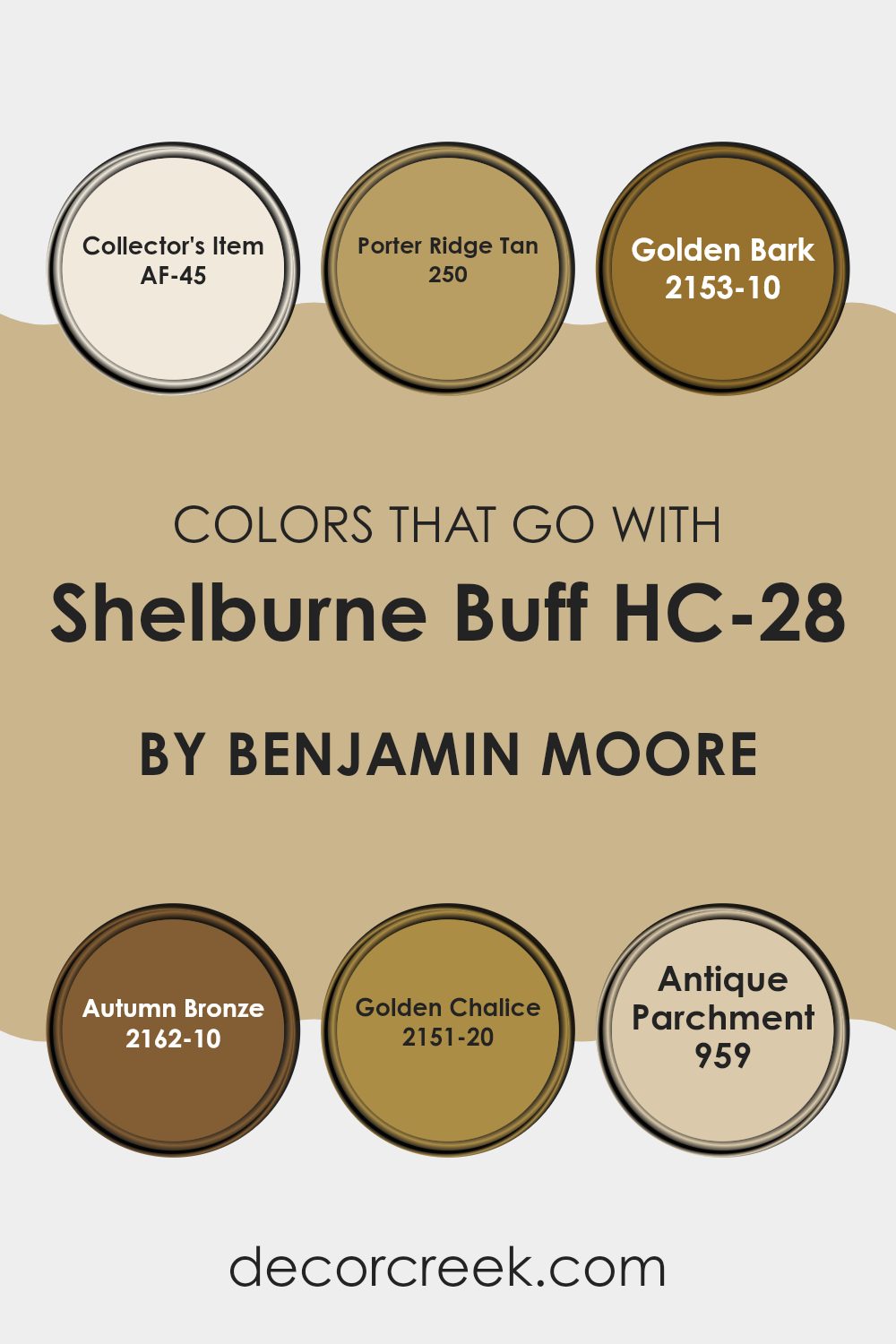
How to Use Shelburne Buff HC-28 by Benjamin Moore In Your Home?
Shelburne Buff HC-28 by Benjamin Moore is a warm, inviting shade of beige that can add a cozy feel to any room in your home. Its softness makes it perfect for living areas where you spend a lot of time, like the living room or den. It pairs beautifully with natural materials like wood, enhancing its comfortable character.
This color is adaptable and can work as a backdrop to vibrant accents like cushions, artwork, or rugs. It’s also great for bedrooms, creating a calm, comfortable atmosphere that’s ideal for relaxing and unwinding at the end of the day. In rooms with less natural light, Shelburne Buff can help brighten the area, making it feel larger and more open.
Because of its neutrality, Shelburne Buff can suit any style, whether your home is traditional or more modern. It’s also a practical choice for common areas and hallways, as it hides minor marks and scuffs, keeping high-traffic zones looking clean and refreshed.
Shelburne Buff HC-28 by Benjamin Moore vs Oat Straw AF-340 by Benjamin Moore
Shelburne Buff and Oat Straw are both warm and welcoming colors by Benjamin Moore. Shelburne Buff is a soft, sandy beige with a comfortable feel that makes it a great choice for living areas where you want a relaxed mood. It adds a touch of warmth and complements a wide range of decor styles.
Oat Straw, in contrast, is a slightly richer hue. It’s a golden beige that carries a bit more warmth compared to Shelburne Buff. Oat Straw is ideal if you want a color that feels a little deeper and gives the room a slightly cozier character without appearing too dark.
Both shades are adaptable, but Shelburne Buff serves as a more neutral, gentle backdrop, while Oat Straw adds a touch more brightness and energy due to its golden tones. The choice between them depends on whether you prefer a more subdued or a slightly livelier feel in your room.
You can see recommended paint color below:
- AF-340 Oat Straw
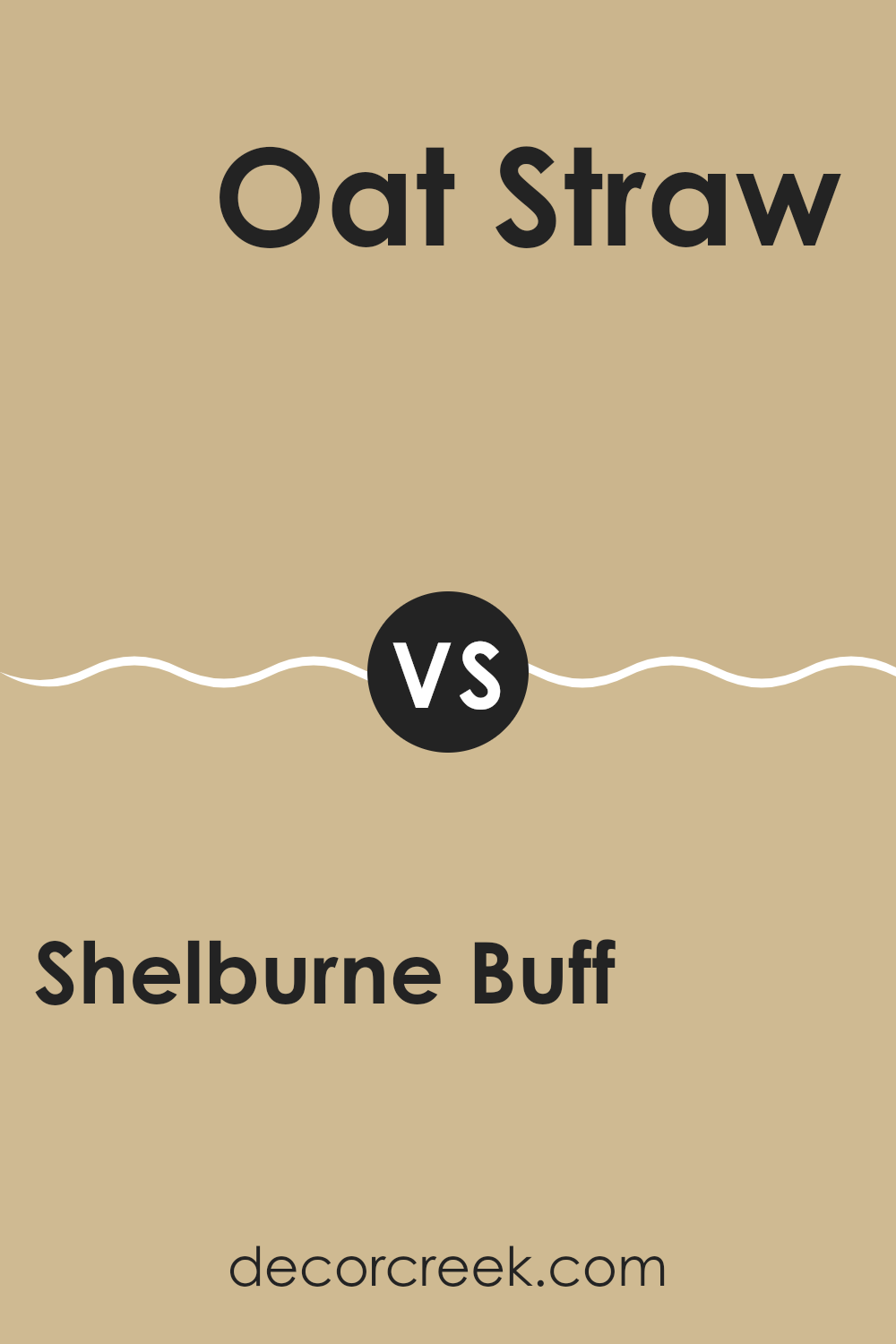
Shelburne Buff HC-28 by Benjamin Moore vs Wilmington Tan HC-34 by Benjamin Moore
Shelburne Buff and Wilmington Tan, both from Benjamin Moore, offer subtle differences in tone that can influence the mood and appearance of a room. Shelburne Buff is a soft, creamy yellow with a warm and welcoming character. It reflects light gently, helping rooms appear brighter and more open. This shade works beautifully in living rooms and bedrooms where a calm, inviting atmosphere is desired.
Wilmington Tan, in contrast, has a deeper beige tone that conveys a stronger sense of warmth. This color is ideal for creating a comfortable and grounded feel, perfect for family rooms or dining areas. It pairs nicely with rich woods and other warm hues, enhancing a sense of depth and stability.
While both colors share the comforting quality of earth tones, Shelburne Buff is lighter and can make a room feel more spacious, whereas Wilmington Tan, being deeper, offers a snug, enveloping effect.
You can see recommended paint color below:
- HC-34 Wilmington Tan
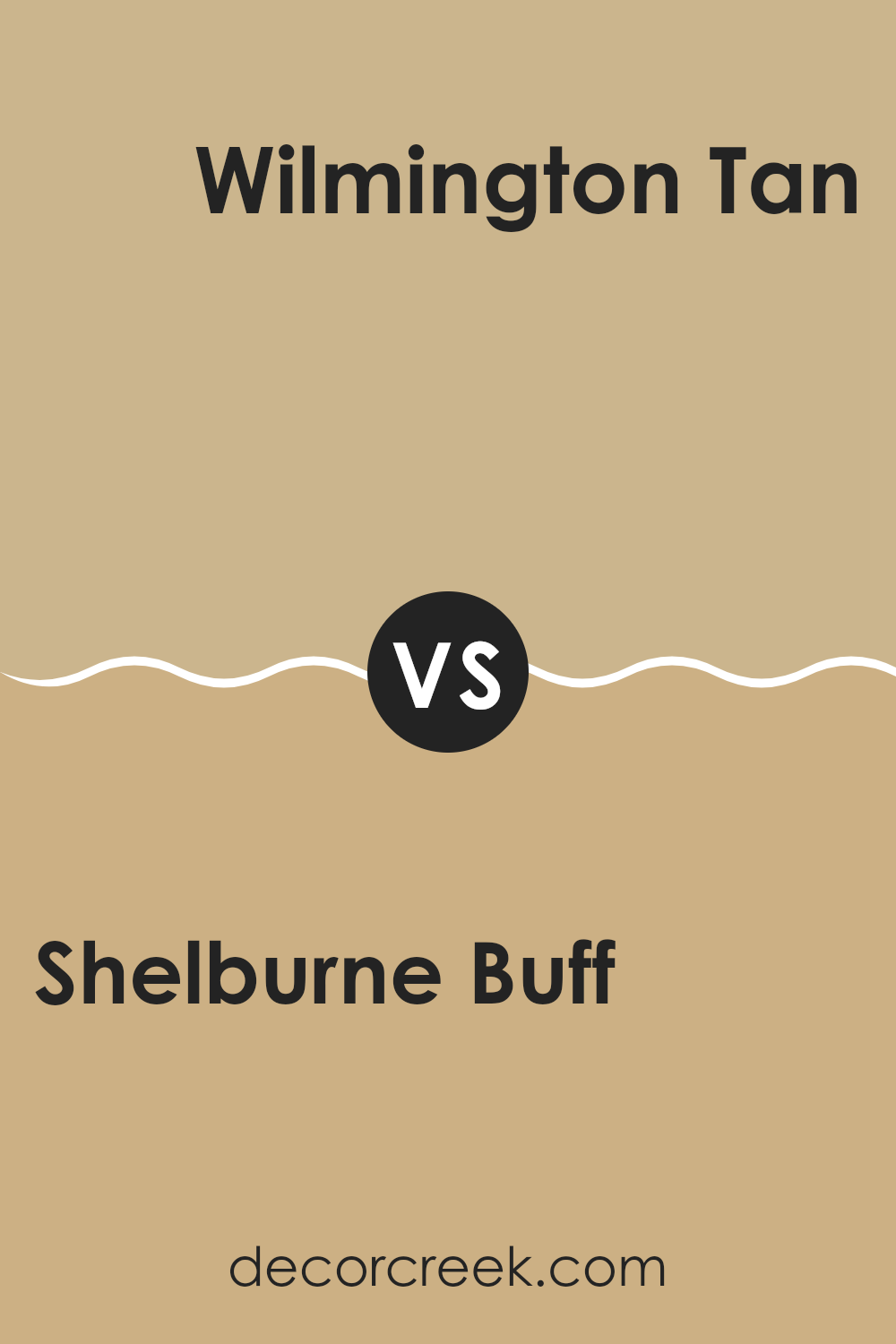
Shelburne Buff HC-28 by Benjamin Moore vs Shakespeare Tan 228 by Benjamin Moore
Shelburne Buff and Shakespeare Tan are two warm and inviting paint colors by Benjamin Moore, each bringing its own charm to a room. Shelburne Buff is a soft, muted yellow with a creamy undertone that adds a comfortable, sunlit touch to interiors, making it perfect for living rooms or kitchens. It offers a welcoming brightness that remains gentle, providing a smooth backdrop that complements many decor styles.
Shakespeare Tan, in contrast, is a deeper and more subdued hue. It leans toward a rich beige with a hint of gray, creating a calm and grounded presence. This shade is ideal for establishing a peaceful atmosphere in bedrooms or studies where a relaxed environment is desired.
While both tones share a warm aesthetic, Shelburne Buff is lighter and better for enhancing natural light. Shakespeare Tan, with its earthier depth, suits areas where a refined and cozy ambiance is preferred.
You can see recommended paint color below:
- 228 Shakespeare Tan
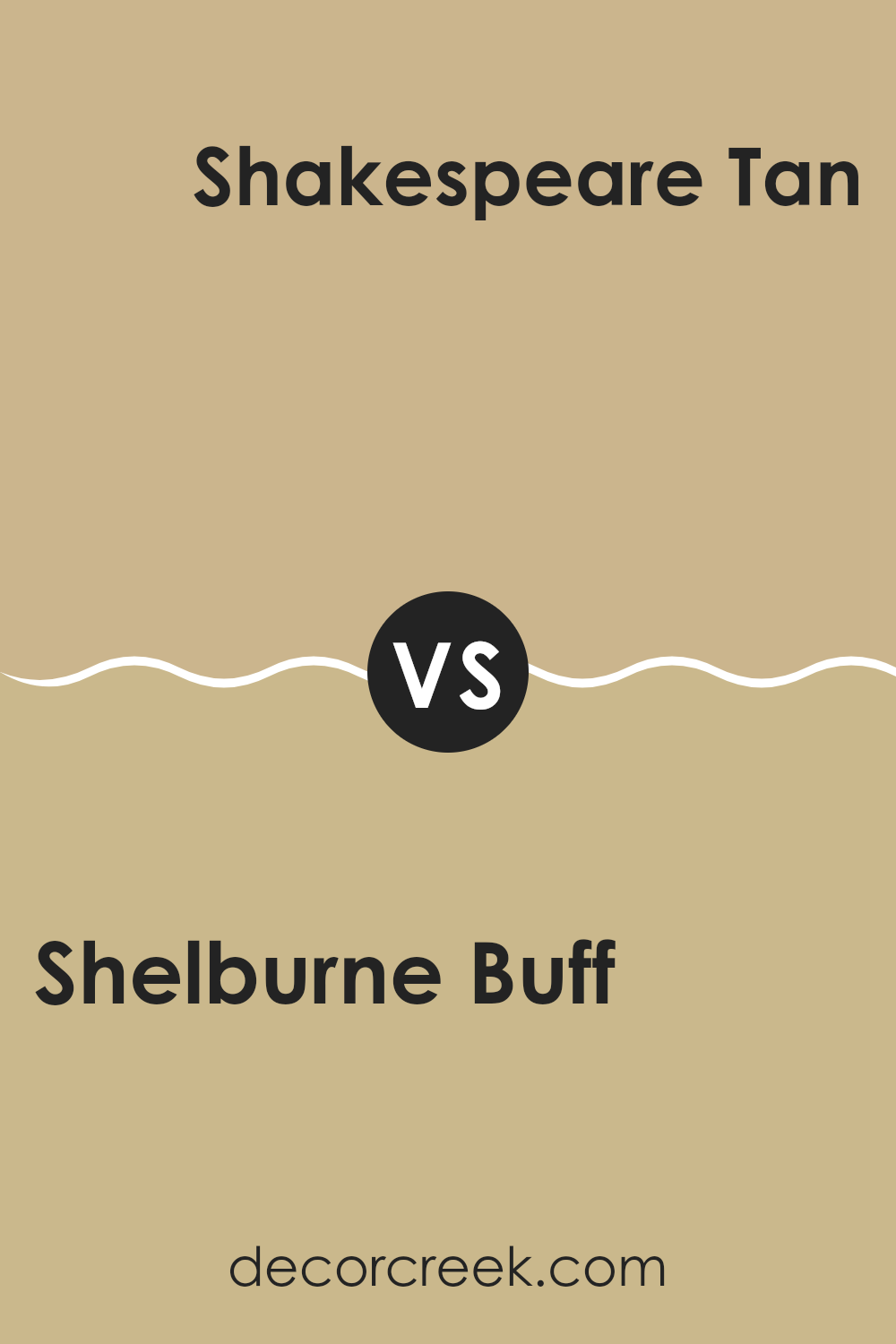
Shelburne Buff HC-28 by Benjamin Moore vs Splendour AF-385 by Benjamin Moore
The two colors from Benjamin Moore, Shelburne Buff and Splendour, present a nice contrast in their tones. Shelburne Buff is a warm and inviting beige with a subtle yellow undertone, which makes it cozy and comfortable for any living area. It’s a type of color that reminds you of soft sand or a warm clay pot, giving a homey feel to the room.
On the other hand, Splendour is a deeper and more vibrant color. It belongs to the family of greens with a bold presence, adding energy and freshness wherever it’s used. This shade would be great in rooms that need a touch of nature or an invigorating lift.
Using Shelburne Buff in zones like the living room or bedroom could create a soft background, while Splendour could act as an accent wall or in areas like a study or kitchen, where its vividness would be both effective and cheerful. Combining them could also offer a balanced palette, with the softness of Shelburne Buff offsetting the lively Splendour for a harmonious blend.
You can see recommended paint color below:
- AF-385 Splendour
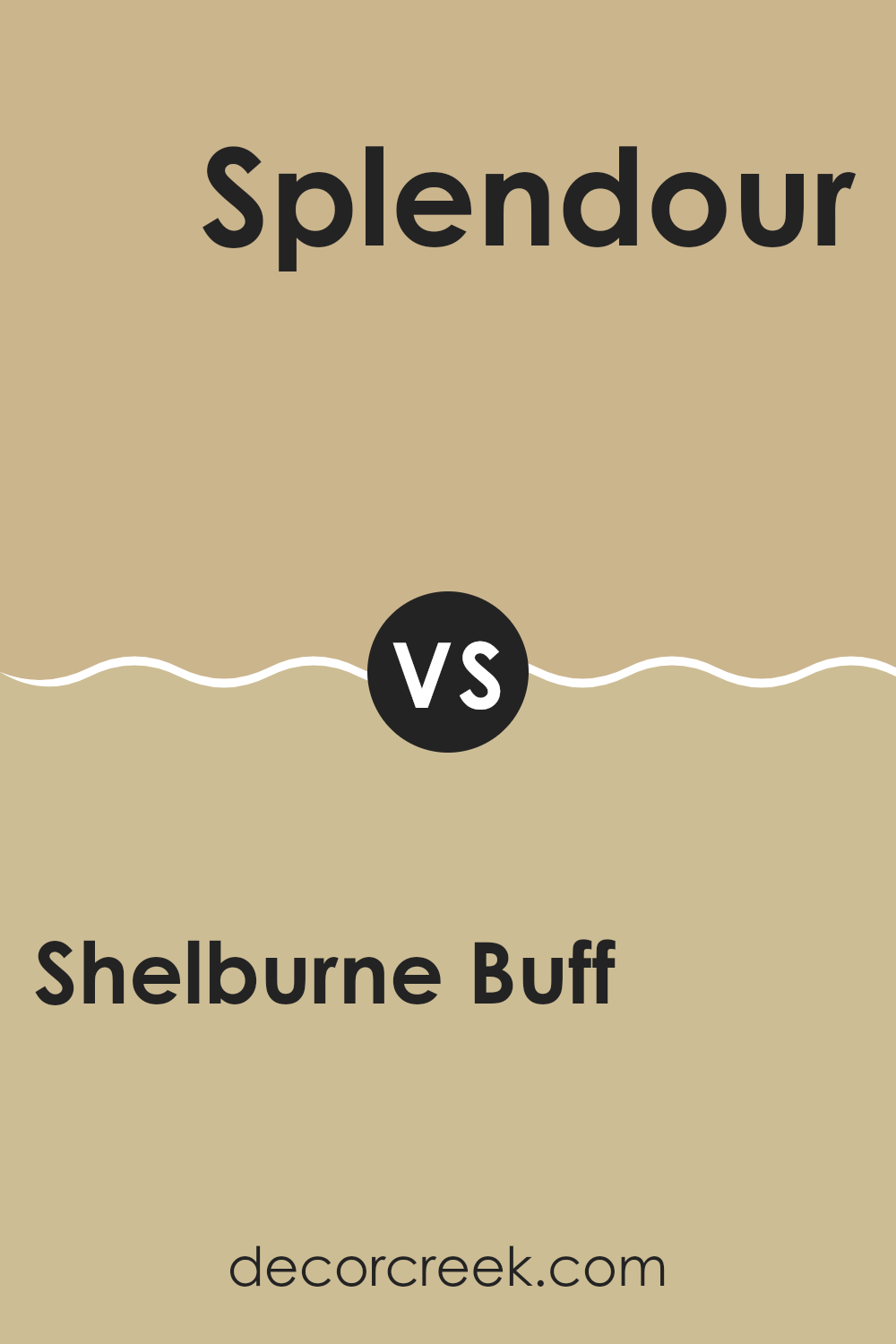
After reading all about HC-28 Shelburne Buff by Benjamin Moore, I’ve realized it’s a really nice paint color for anyone looking to freshen up their room. It has a warm, welcoming feel that makes any room feel cozy, just like when you’re wrapped up in a soft blanket. This color isn’t too bright or too dark, so it feels just right in many different areas of a house, whether it’s a living room, bedroom, or even a kitchen.
What’s great about Shelburne Buff is how it works with other colors. You can pair it with dark shades like brown or black for a grounded look, or match it with lighter tones like white to make it feel more open and airy. It also looks good with different materials and furniture, whether you have old wooden pieces or modern metal designs.
As someone who enjoys a comfortable and inviting home, I think HC-28 Shelburne Buff is a really good choice for painting walls. It’s definitely a color that will help make your house feel like a home. So if you’re thinking about giving your walls a new look, this color could be the perfect pick for you!
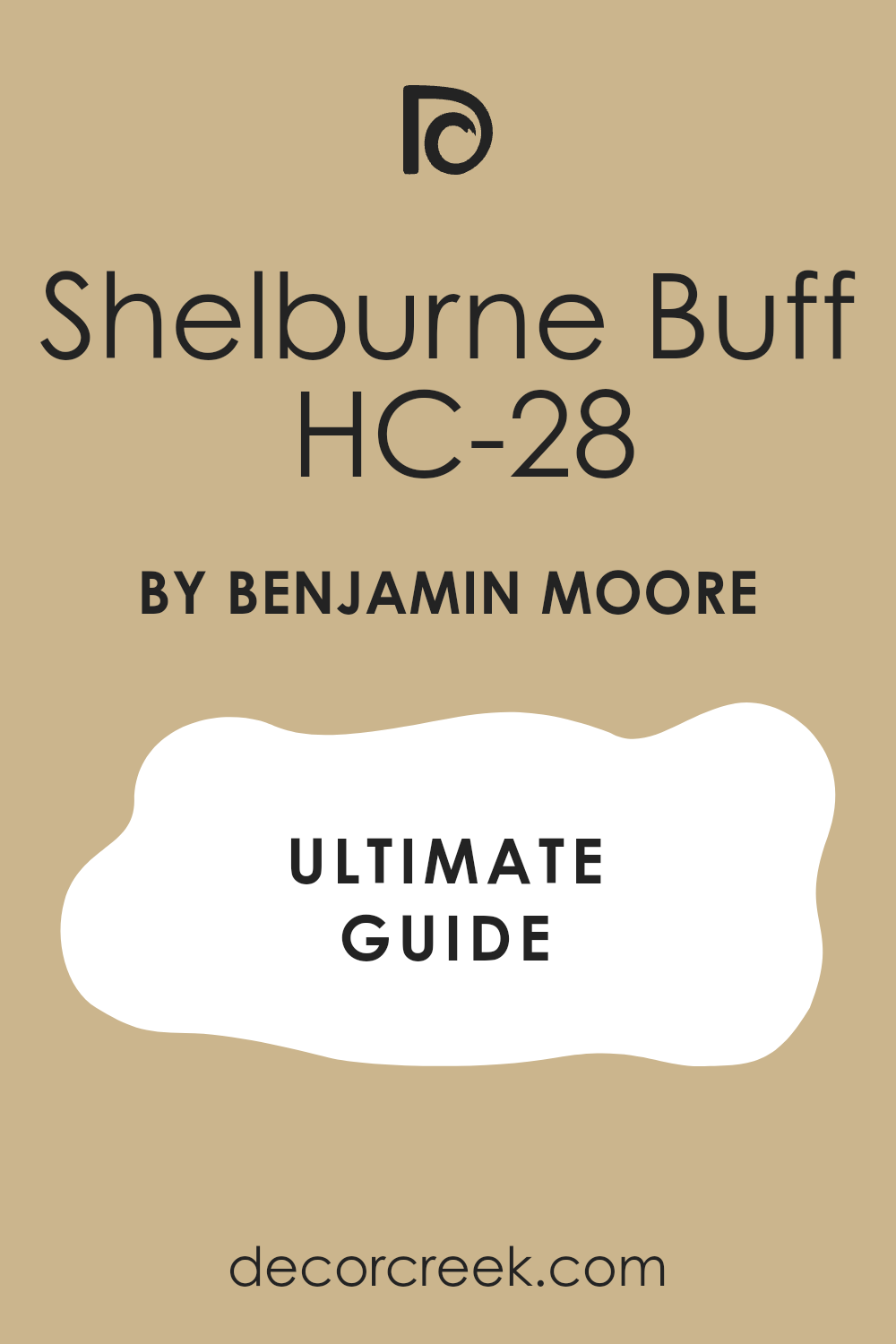
Ever wished paint sampling was as easy as sticking a sticker? Guess what? Now it is! Discover Samplize's unique Peel & Stick samples.
Get paint samples



